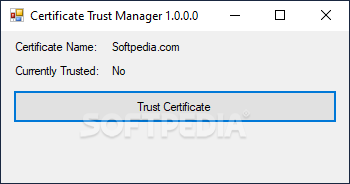
CertTrustManager
1.0.0.0This small Windows program allows users to load CER certificates and either trust or untrust them for later use and distribution
An SSL or TLS certificate is a cryptographic protocol that encrypts data on servers, applications, computers, and so on. SSL stands for Secure Socket Layer, while TLS means Transport Layer Security. Over time, TLS has become the standard since some vulnerabilities have been discovered in some SSL protocols.
Now that we know more about certificates let's move on to a program called CertTrustManager.
That is a small application that allows users to trust or untrust SSL/TLS certificates. The program doesn't require any technical knowledge regarding SSL or TLS certification.
Download the program, extract it from the archive, and open it. A small box will pop up, and you will have to right-click anywhere in it to load a certificate. Note that the program only supports the CER format. Accordingly, you cannot use the PFX format for certificates.
Once you have opened a document, CertTrustManager will build an executable file. Double-click it, and you will have the option to trust that respective certificate. If you have already trusted it, the button will read "Untrust Certificate."
After you have created a certificate and added it to the program, you can share the embedded certificate with other people. They can straightforwardly trust your document by simply accessing the executable. A screen will show up with a button reading "Trust Certificate."
Also, if a certificate is already trusted, people will see the untrust option.
CertTrustManager is a handy tool in case you need it. If you are an app designer, you might need to build certificates for your work. These documents are not trusted by default when they are self-signed, so using a program to do that might be helpful. To make your own certificates, you can try SSL Certificate Maker, created by the same dev behind CertTrustManager.
In conclusion, this lightweight, straightforward program does what it promises to do, but it lacks some elements, such as a more responsive user interface.
Now that we know more about certificates let's move on to a program called CertTrustManager.
That is a small application that allows users to trust or untrust SSL/TLS certificates. The program doesn't require any technical knowledge regarding SSL or TLS certification.
How CertTrustManager works
Download the program, extract it from the archive, and open it. A small box will pop up, and you will have to right-click anywhere in it to load a certificate. Note that the program only supports the CER format. Accordingly, you cannot use the PFX format for certificates.
Once you have opened a document, CertTrustManager will build an executable file. Double-click it, and you will have the option to trust that respective certificate. If you have already trusted it, the button will read "Untrust Certificate."
Distribute the embedded certificate
After you have created a certificate and added it to the program, you can share the embedded certificate with other people. They can straightforwardly trust your document by simply accessing the executable. A screen will show up with a button reading "Trust Certificate."
Also, if a certificate is already trusted, people will see the untrust option.
Is this program useful?
CertTrustManager is a handy tool in case you need it. If you are an app designer, you might need to build certificates for your work. These documents are not trusted by default when they are self-signed, so using a program to do that might be helpful. To make your own certificates, you can try SSL Certificate Maker, created by the same dev behind CertTrustManager.
In conclusion, this lightweight, straightforward program does what it promises to do, but it lacks some elements, such as a more responsive user interface.
10 KB
Info
Update Date
Oct 30 2019
Version
1.0.0.0
License
The Unlicense
Created By
bp2008
Related software Portable







